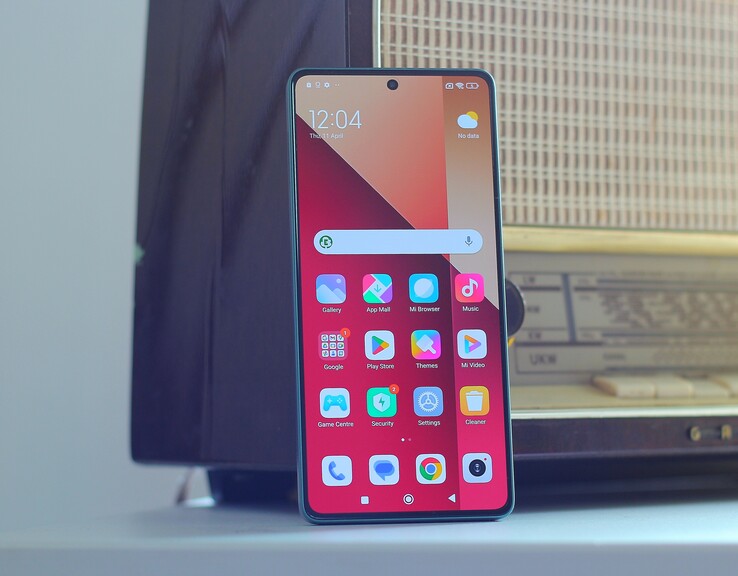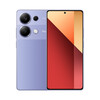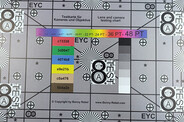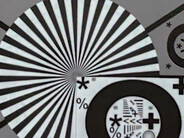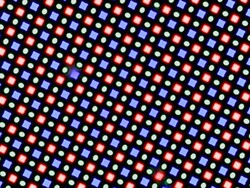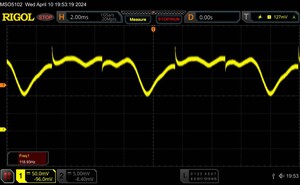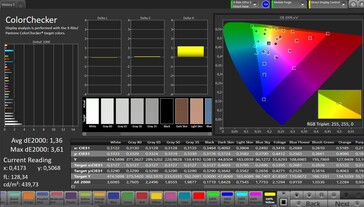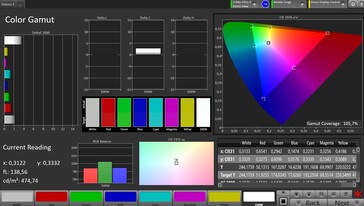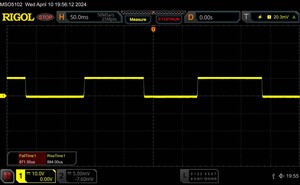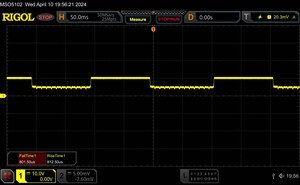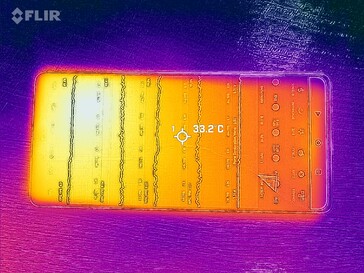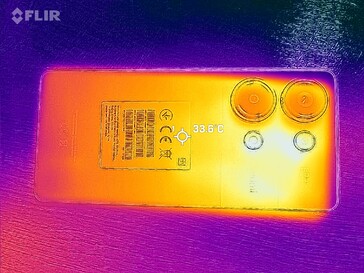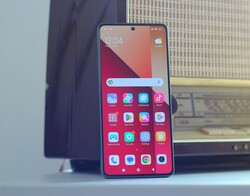小米Redmi Note 13 Pro 4G 智能手机评测--配备 AMOLED 显示屏和出色摄像头的中端手机
潜在的竞争对手比较
Rating | Date | Model | Weight | Drive | Size | Resolution | Price |
|---|---|---|---|---|---|---|---|
| 82.5 % v7 (old) | 05 / 2024 | Xiaomi Redmi Note 13 Pro 4G Helio G99, Mali-G57 MP2 | 188 g | 512 GB UFS 2.2 Flash | 6.67" | 2400x1080 | |
| 85.8 % v7 (old) | 01 / 2024 | Xiaomi Redmi Note 13 Pro 5G SD 7s Gen 2, Adreno 710 | 187 g | 256 GB UFS 2.2 Flash | 6.67" | 2712x1220 | |
| 83.9 % v7 (old) | 02 / 2024 | Honor Magic6 Lite SD 6 Gen 1, Adreno 710 | 185 g | 256 GB UFS 3.1 Flash | 6.78" | 2652x1200 | |
| 81.9 % v7 (old) | 12 / 2022 | Motorola Moto G72 Helio G99, Mali-G57 MP2 | 166 g | 128 GB UFS 2.2 Flash | 6.60" | 2400x1080 |
» Notebookcheck多媒体笔记本电脑Top 10排名
» Notebookcheck游戏笔记本电脑Top 10排名
» Notebookcheck低价办公/商务笔记本电脑Top 10排名
» Notebookcheck高端办公/商务笔记本电脑Top 10排名
» Notebookcheck工作站笔记本电脑Top 10排名
» Notebookcheck亚笔记本电脑Top 10排名
» Notebookcheck超级本产品Top 10排名
» Notebookcheck变形本产品Top 10排名
» Notebookcheck平板电脑Top 10排名
» Notebookcheck智能手机Top 10排名
» Notebookcheck评测过最出色的笔记本电脑屏幕
» Notebookcheck售价500欧元以下笔记本电脑Top 10排名
» Notebookcheck售价300欧元以下笔记本电脑Top 10排名
外壳和功能 - 高质量塑料外壳
并非所有智能手机买家都需要 5G,因此,一款价格略低的高品质 4G 中端手机仍有发展空间。这就是小米Redmi Note 13 Pro 4G 隆重登场的原因,因为它带来了 13 Pro 5G 的许多优势。 Redmi Note 13 Pro 5G但价格便宜 50 欧元。
虽然背面相似,但小米在设计上做了一些改动,使 4G 机型一眼就能辨认出来。在颜色和手感方面,该机没有突出的一组相机模块,而是在外壳中安装了单独的镜头。背面上部有两条稍浅的条纹。可选颜色有绿色、紫色和黑色。
4G 机型正面的显示屏边缘也非常纤薄,前置摄像头的打孔也非常小。即使用力也很难扭动设备,整体看起来非常稳定。所有边角都做了圆滑处理,使手机握在手中非常舒适。
该机提供 IP54 级防尘和防水溅保护,但不应将设备浸入水中。
小米Redmi Note 13 Pro 4G 提供两种存储版本:
- 8 GB 内存 / 256 GB 存储空间:349欧元
- 12 GB RAM / 512 GB 存储空间:399 欧元
手机配备了 NFC 功能和红外线发射器,可用作其他设备的遥控器。此外还有一个 3.5 毫米音频接口。
与 Redmi Note 13 Pro 5G不支持 eSIM 卡,但有一个 microSD 读卡器。它占用了两个 SIM 卡插槽中的一个,在我们使用 Angelbird V60 参考存储卡进行的测试中,它的速度在同价位产品中表现平平。
| SD Card Reader - average JPG Copy Test (av. of 3 runs) | |
| Xiaomi Redmi Note 13 Pro 4G (Angelbird V60) | |
| Motorola Moto G72 (Angelbird V60) | |
Cross Platform Disk Test (CPDT)
通信、软件和操作 - 更新至 2028 年
由于有许多 4G 频率,这款智能手机还可以在旅行时用于许多国家的移动互联网。在测试期间,我们很喜欢它的接收质量。
WiFi 5 是Redmi Note 13 Pro 4G 支持的最快的 Wi-Fi 标准。速度约为 300 - 350 MBit/s。该设备的 Wi-Fi 速度比 5G 版慢,几乎只有 5G 版的一半。不过,这只有在日常使用大容量下载时才会明显感觉到。
小米安装了Android 13 ex-works,并叠加了旧版 MIUI 界面,但现在也可以更新到Android 14 和小米的新 HyperOS。在测试时,安全补丁是从 2024 年 3 月开始的,因此仍然是合理的最新版本。小米希望在 2028 年之前再提供两个操作系统版本和安全补丁。
手机上预装了不少应用程序,包括许多广告应用程序和游戏。因此,如果你想要一个干净的系统,就必须删除其中一些。
120 Hz 的屏幕可实现极快的输入速度和响应速度,即使在边角位置也是如此。指纹传感器集成在显示屏中,解锁手机非常快速可靠。人脸识别功能也能完美运行,即使在昏暗的光线下也是如此。
| Networking | |
| Xiaomi Redmi Note 13 Pro 4G | |
| iperf3 receive AXE11000 | |
| iperf3 transmit AXE11000 | |
| Xiaomi Redmi Note 13 Pro 5G | |
| iperf3 receive AXE11000 | |
| iperf3 transmit AXE11000 | |
| Honor Magic6 Lite | |
| iperf3 receive AXE11000 | |
| iperf3 transmit AXE11000 | |
| Motorola Moto G72 | |
| iperf3 receive AXE11000 | |
| iperf3 transmit AXE11000 | |
| Average of class Smartphone | |
| iperf3 receive AXE11000 | |
| iperf3 transmit AXE11000 | |
相机 - 高质量中档相机
Redmi Note 13 Pro 5G 的高品质摄像头系统也被 4G 机型所采用。手机背面的照片通常由 20000 万像素的主摄像头拍摄,该摄像头通常将每 16 个像素组合在一起,以获得更高的得光率,从而拍摄出 1200 万像素的照片。全分辨率可在特殊模式下使用。光学稳定器可防止图像模糊。
主摄像头拍摄的照片细节丰富,在较暗的环境下亮度也很高,令人赏心悦目。我们还发现照片的清晰度也不错,尽管在某些区域会出现一些抖动。
4G 机型只能以 1080p 和 60 fps 的速度录制视频;5G 机型的 4K 功能已被取消。
广角摄像头提供 800 万像素,拍照效果不错,但边缘清晰度明显下降。小米还安装了一个 200 万像素的微距摄像头,用于拍摄极限特写。该摄像头适合拍摄快照,但不宜将图像放大太多。
前置自拍摄像头分辨率为 1600 万像素。照片看起来光线还算不错,细节也符合这个价位的水平。
Image Comparison
Choose a scene and navigate within the first image. One click changes the position on touchscreens. One click on the zoomed-in image opens the original in a new window. The first image shows the scaled photograph of the test device.
Main cameraMain cameraLow LightUltra wide-angle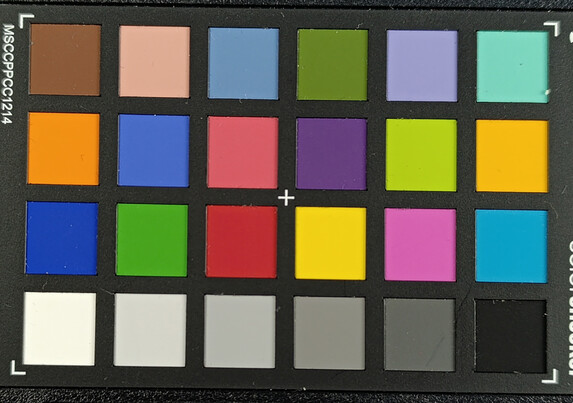
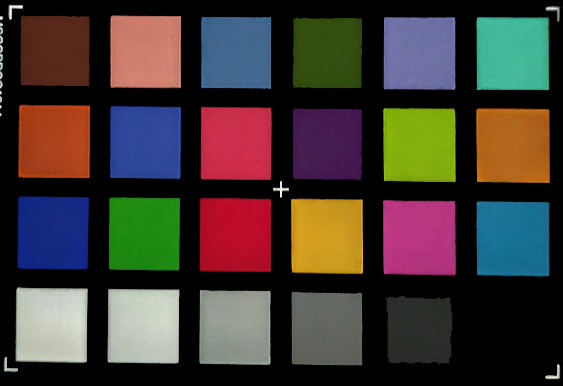
显示屏 - 明亮的真彩 AMOLED
| |||||||||||||||||||||||||
Brightness Distribution: 95 %
Center on Battery: 994 cd/m²
Contrast: ∞:1 (Black: 0 cd/m²)
ΔE Color 1.36 | 0.5-29.43 Ø4.87
ΔE Greyscale 2.2 | 0.5-98 Ø5.1
105.7% sRGB (Calman 2D)
Gamma: 2.287
| Xiaomi Redmi Note 13 Pro 4G AMOLED, 2400x1080, 6.7" | Xiaomi Redmi Note 13 Pro 5G AMOLED, 2712x1220, 6.7" | Honor Magic6 Lite AMOLED, 2652x1200, 6.8" | Motorola Moto G72 P-OLED, 2400x1080, 6.6" | |
|---|---|---|---|---|
| Screen | -0% | 23% | -67% | |
| Brightness middle | 994 | 1205 21% | 1003 1% | 992 0% |
| Brightness | 979 | 1177 20% | 1007 3% | 980 0% |
| Brightness Distribution | 95 | 90 -5% | 96 1% | 92 -3% |
| Black Level * | ||||
| Colorchecker dE 2000 * | 1.36 | 1.51 -11% | 0.8 41% | 4.56 -235% |
| Colorchecker dE 2000 max. * | 3.61 | 4.07 -13% | 2.4 34% | 7.96 -120% |
| Greyscale dE 2000 * | 2.2 | 2.5 -14% | 0.9 59% | 3.1 -41% |
| Gamma | 2.287 96% | 2.175 101% | 2.18 101% | 2.233 99% |
| CCT | 6392 102% | 6407 101% | 6406 101% | 7098 92% |
* ... smaller is better
Screen Flickering / PWM (Pulse-Width Modulation)
| Screen flickering / PWM detected | 119 Hz | ||
The display backlight flickers at 119 Hz (worst case, e.g., utilizing PWM) . The frequency of 119 Hz is very low, so the flickering may cause eyestrain and headaches after extended use. In comparison: 53 % of all tested devices do not use PWM to dim the display. If PWM was detected, an average of 8516 (minimum: 5 - maximum: 343500) Hz was measured. | |||
具有固定缩放级别和不同亮度设置的测量系列
Display Response Times
| ↔ Response Time Black to White | ||
|---|---|---|
| 1.8 ms ... rise ↗ and fall ↘ combined | ↗ 0.9 ms rise | |
| ↘ 0.9 ms fall | ||
| The screen shows very fast response rates in our tests and should be very well suited for fast-paced gaming. In comparison, all tested devices range from 0.1 (minimum) to 240 (maximum) ms. » 8 % of all devices are better. This means that the measured response time is better than the average of all tested devices (20.8 ms). | ||
| ↔ Response Time 50% Grey to 80% Grey | ||
| 1.6 ms ... rise ↗ and fall ↘ combined | ↗ 0.8 ms rise | |
| ↘ 0.8 ms fall | ||
| The screen shows very fast response rates in our tests and should be very well suited for fast-paced gaming. In comparison, all tested devices range from 0.165 (minimum) to 636 (maximum) ms. » 5 % of all devices are better. This means that the measured response time is better than the average of all tested devices (32.5 ms). | ||
性能、排放和电池寿命 - 功耗相当低
采用 联发科 Helio G99小米选择了一款相当慢的 SoC,与 Redmi Note 13 Pro 5G你不得不接受明显的性能损失。现在,其他制造商也在这个价位提供速度更快的手机。
在日常使用中,Redmi Note 13 Pro 4G 并不是一款速度很慢的手机;在大多数情况下,都可以流畅地浏览菜单。只有在运行多任务或更复杂的应用程序时,性能上的差异才会非常明显。小米选择了 UFS 2.2 闪存,速度快,加载时间短。
长时间使用后,手机外壳的温度会升高到 40.8 °C;我们是在室温下测量的。这很明显,但并不严重,3DMark 压力测试表明,即使在长时间负载的情况下,SoC 也能保持其性能。
底部边缘的扬声器由听筒支持,因此可以实现立体声音效。声音饱满而温暖,听音乐是一种享受。当然,在大多数情况下,你不得不放弃低音和中低音,但对于中档手机来说,我们喜欢这样的音效。
如果您想要更好的音效,可以通过 3.5 毫米插孔或蓝牙连接耳机或扬声器。蓝牙支持目前几乎所有的无线编解码器。
电池容量为 5000 毫安时,比 5G 机型略小,但在我们的 Wi-Fi 测试中仍能保持 16 小时以上的良好续航时间。这意味着你可以在不充电的情况下连续使用一天。如果手机确实需要插电,可通过随附的电源适配器以高达 67 瓦的功率充电,因此只需不到一小时就能充满电。
| Xiaomi Redmi Note 13 Pro 4G | Xiaomi Redmi Note 13 Pro 5G | Honor Magic6 Lite | Motorola Moto G72 | Average 512 GB UFS 2.2 Flash | Average of class Smartphone | |
|---|---|---|---|---|---|---|
| AndroBench 3-5 | -0% | 29% | -12% | 10% | 71% | |
| Sequential Read 256KB | 933.8 | 946.8 1% | 1827.3 96% | 868.5 -7% | 1033 ? 11% | 2030 ? 117% |
| Sequential Write 256KB | 795.4 | 808.2 2% | 843.34 6% | 497.5 -37% | 950 ? 19% | 1646 ? 107% |
| Random Read 4KB | 246.8 | 239.2 -3% | 223.75 -9% | 231.4 -6% | 232 ? -6% | 282 ? 14% |
| Random Write 4KB | 222.2 | 220.5 -1% | 271.22 22% | 230.2 4% | 259 ? 17% | 325 ? 46% |
| Xiaomi Redmi Note 13 Pro 4G | Xiaomi Redmi Note 13 Pro 5G | Honor Magic6 Lite | Average 512 GB UFS 2.2 Flash | Average of class Smartphone | |
|---|---|---|---|---|---|
| PCMark for Android | -19% | 9% | -5% | 48% | |
| Storage 2.0 seq. read int. | 819 ? | 758 ? -7% | 765 ? -7% | 1590 ? 94% | |
| Storage 2.0 seq. write int. | 726 ? | 776 ? 7% | 704 ? -3% | 1460 ? 101% | |
| Storage 2.0 random read int. | 45.4 ? | 25.7 ? -43% | 41.9 ? -8% | 39.8 ? -12% | |
| Storage 2.0 random write int. | 67.7 ? | 41.2 ? -39% | 59 ? -13% | 63.8 ? -6% | |
| Storage 2.0 | 26431 ? | 23116 ? -13% | 28736 9% | 27961 ? 6% | 42739 ? 62% |
(±) The maximum temperature on the upper side is 40.8 °C / 105 F, compared to the average of 35.1 °C / 95 F, ranging from 21.9 to 63.7 °C for the class Smartphone.
(+) The bottom heats up to a maximum of 38.8 °C / 102 F, compared to the average of 33.9 °C / 93 F
(+) In idle usage, the average temperature for the upper side is 25 °C / 77 F, compared to the device average of 32.8 °C / 91 F.
3DMark Wild Life Stress Test
| 3DMark | |
| Wild Life Stress Test Stability | |
| Honor Magic6 Lite | |
| Xiaomi Redmi Note 13 Pro 5G | |
| Xiaomi Redmi Note 13 Pro 4G | |
| Motorola Moto G72 | |
| Wild Life Extreme Stress Test | |
| Xiaomi Redmi Note 13 Pro 5G | |
| Motorola Moto G72 | |
| Honor Magic6 Lite | |
| Xiaomi Redmi Note 13 Pro 4G | |
Xiaomi Redmi Note 13 Pro 4G audio analysis
(±) | speaker loudness is average but good (81.6 dB)
Bass 100 - 315 Hz
(-) | nearly no bass - on average 25.4% lower than median
(±) | linearity of bass is average (10.7% delta to prev. frequency)
Mids 400 - 2000 Hz
(±) | higher mids - on average 6.6% higher than median
(±) | linearity of mids is average (7.3% delta to prev. frequency)
Highs 2 - 16 kHz
(±) | higher highs - on average 5.3% higher than median
(+) | highs are linear (6.8% delta to prev. frequency)
Overall 100 - 16.000 Hz
(±) | linearity of overall sound is average (23.8% difference to median)
Compared to same class
» 51% of all tested devices in this class were better, 9% similar, 40% worse
» The best had a delta of 12%, average was 36%, worst was 134%
Compared to all devices tested
» 69% of all tested devices were better, 7% similar, 24% worse
» The best had a delta of 4%, average was 24%, worst was 134%
Motorola Moto G72 audio analysis
(+) | speakers can play relatively loud (85.4 dB)
Bass 100 - 315 Hz
(-) | nearly no bass - on average 28.3% lower than median
(±) | linearity of bass is average (12.5% delta to prev. frequency)
Mids 400 - 2000 Hz
(±) | higher mids - on average 5.6% higher than median
(+) | mids are linear (4.7% delta to prev. frequency)
Highs 2 - 16 kHz
(+) | balanced highs - only 4.2% away from median
(+) | highs are linear (6% delta to prev. frequency)
Overall 100 - 16.000 Hz
(±) | linearity of overall sound is average (21.2% difference to median)
Compared to same class
» 37% of all tested devices in this class were better, 8% similar, 55% worse
» The best had a delta of 12%, average was 36%, worst was 134%
Compared to all devices tested
» 56% of all tested devices were better, 7% similar, 37% worse
» The best had a delta of 4%, average was 24%, worst was 134%
| Xiaomi Redmi Note 13 Pro 4G 5000 mAh | Xiaomi Redmi Note 13 Pro 5G 5100 mAh | Honor Magic6 Lite 5300 mAh | Motorola Moto G72 5000 mAh | |
|---|---|---|---|---|
| Battery Runtime | ||||
| WiFi v1.3 | 969 | 1002 3% | 906 -7% | 929 -4% |
Pros
Cons
结论 - 与 5G 机型相比,设备差异显著
小米Redmi Note 13 Pro 4G 是一款出色的中端手机,但在其 5G 兄弟面前却有些黯然失色。虽然它拥有同样高品质的相机系统,但却没有最大亮度。你还必须接受较低的屏幕分辨率、没有 4K 视频录制功能、较慢的 Wi-Fi 速度以及不支持 eSIM 卡。此外,顾名思义,它还不能使用 5G 网络,性能也会大打折扣。
对于 50 欧元的差价,根据零售商的不同又会有不同的看法,小米采取的成本削减措施还真不少。小米 Redmi Note 13 Pro 5G绝对是一个强有力的竞争对手,你应该考虑为它的诸多优势支付一点溢价。
不过,就我们的测试设备本身而言,时尚现代的外壳、快速充电、良好的运行时间、明亮且色彩真实的屏幕以及出色的功能都给人留下了深刻印象。因此,它绝对是一款值得购买的产品。几乎没有真正的弱点:软件方面,内置了大量臃肿的软件,这不是它的亮点,而且屏幕的 PWM 闪烁可能会给敏感人群带来困扰。
小米Redmi Note 13 Pro 4G 是一款性能强劲的中端手机,它的竞争对手是配置更高的 5G 机型。
如果你想换个品牌,可以看看 摩托罗拉 Edge 40 Neo或 Honor Magic6 Lite这两款手机都提供 5G,而且降价后价格已经相当实惠。
价格和供应情况
截至发稿时,配备 512GB 大容量存储的小米Redmi Note 13 Pro 4G 可直接从制造商处购买。另外,感兴趣的用户也可以通过亚马逊订购Redmi Note 13 Pro 4G,价格约为 270 美元。
Xiaomi Redmi Note 13 Pro 4G
- 05/03/2024 v7 (old)
Florian Schmitt
Transparency
The selection of devices to be reviewed is made by our editorial team. The test sample was provided to the author as a loan by the manufacturer or retailer for the purpose of this review. The lender had no influence on this review, nor did the manufacturer receive a copy of this review before publication. There was no obligation to publish this review. We never accept compensation or payment in return for our reviews. As an independent media company, Notebookcheck is not subjected to the authority of manufacturers, retailers or publishers.
This is how Notebookcheck is testing
Every year, Notebookcheck independently reviews hundreds of laptops and smartphones using standardized procedures to ensure that all results are comparable. We have continuously developed our test methods for around 20 years and set industry standards in the process. In our test labs, high-quality measuring equipment is utilized by experienced technicians and editors. These tests involve a multi-stage validation process. Our complex rating system is based on hundreds of well-founded measurements and benchmarks, which maintains objectivity. Further information on our test methods can be found here.




